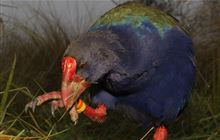Best breeding season for endangered takahē
Archived content: This media release was accurate on the date of publication.
Introduction
The Takahē Recovery Programme celebrates the best ever breeding season for takahē.Date: 25 March 2017 Source: Minister for the Office of Conservation
Conservation Minister Maggie Barry congratulates DOC’s Takahē Recovery Programme, Ngāi Tahu and Fulton Hogan, who are celebrating the best ever breeding season for the critically endangered takahē.
“For the third year running chicks have been produced in record numbers, both in the wild and predator-controlled sanctuaries. 50 takahē juveniles were produced this year across the captive breeding population at sanctuary sites, and a further 16 birds by the wild population in the Murchison Mountains,” Ms Barry says.
“With 66 chicks hatched, the programme has seen an unprecedented 40 per cent increase on last year’s record of 47. Takahē were once thought extinct, but their numbers are growing all the time and the population reached a milestone 300 birds last year.”
“Outside of the wild population and DOC’s Burwood breeding centre, takahē are located at 17 sanctuaries around the country. It’s the dedication and hard work of staff and partner organisations that makes a real difference to the success of the Takahē Recovery Programme,” Ms Barry says.
“Fulton Hogan signed up as the national partner for the Recovery Programme in July 2016 and with their support the Programme is on track to establish a second wild population on the mainland.”
“In preparation for life in the wild 12 of this season’s juveniles from Orokonui EcoSanctuary, Te Anau Wildlife Sanctuary, Cape Sanctuary and Mana and Tiritiri Matangi islands will be transferred to the Burwood breeding centre in April. The young birds will learn vital skills such as tussock feeding from established birds.”
“We’re hoping that in a year’s time these birds will be ready to go into the wild either joining those in the Murchison Mountains or into an as yet undetermined new second site.”
“The Murchison birds are protected by New Zealand’s largest stoat-trapping network. Every three months 2,500 traps are checked, cleared and reset. It’s an example of the dedication and team effort needed to make New Zealand Predator Free by 2050.”
“As well as Fulton Hogan, DOC has strong and ongoing support from Ngāi Tahu and Mitre 10, the programme’s official supplier. This partnership a successful network of scientists, veterinary support, and public and private organisations all working towards increasing takahē numbers,” Ms Barry says.
“Today, Fulton Hogan staff and their families get to see first-hand at Orokonui EcoSanctuary near Dunedin the work bringing these critically endangered birds back from the brink of extinction. “
Contact
For media enquiries contact:
Email: media@doc.govt.nz


